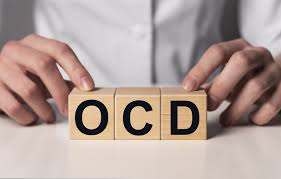If you are struggling with Harm OCD, you may be wondering what ERP for Harm OCD is. And whether or not it is right for you. This blog post will answer those questions and more! We will discuss what ERP is, and how it can help you manage your OCD symptoms. Also, we will provide some of the benefits and risks of this treatment approach.
Contents
What Is ERP?
 ERP stands for Exposure Response and Prevention. It is an evidence-based psychological treatment for anxiety disorders that helps people to confront their fears in a safe and controlled environment. ERP involves gradually exposing the individual to the feared object. Or situation while providing them with helpful tools and strategies to manage their anxiety.
ERP stands for Exposure Response and Prevention. It is an evidence-based psychological treatment for anxiety disorders that helps people to confront their fears in a safe and controlled environment. ERP involves gradually exposing the individual to the feared object. Or situation while providing them with helpful tools and strategies to manage their anxiety.
This is a type of therapy that is highly recommended for those suffering from social anxiety, panic disorder, and obsessive-compulsive disorder (OCD). It can help individuals to develop strategies to control their anxiety. And reduce their fear of triggers that may cause it.
Therefore, if you are considering therapy for Harm OCD or any other type of OCD, ERP is a good option to consider. It can help you confront your fears in a safe and controlled environment. While giving you the tools and strategies to manage your anxiety effectively. ERP is often conducted with a therapist or counselor who will work closely with the individual to create an exposure plan.
How Does ERP For Harm OCD Work?
ERP for harm OCD is a form of exposure-based cognitive behavioral therapy (CBT). The goal of ERP is to help individual confront their fears and reduce their anxiety by gradually exposing them to the source of their fear. During this process, patients are taught to identify and challenge their irrational thoughts. And replace them with more rational thinking.
Patients learn to recognize the irrationality of their thoughts and how this will lead to anxiety-provoking behavior. Through gradually increasing exposure, patients can eventually face their fear without feeling overwhelmed or anxious.
ERP for harm OCD typically involves a combination of cognitive restructuring and re-exposure exercises. During the cognitive restructuring, therapists help the patient identify. And confront the irrational belief that is causing their anxiety. The patient will then be taught how to question and challenge these irrational beliefs by replacing them with more rational thoughts.
During the re-exposure exercises, patients are gradually exposed to their fear in a safe environment. This can range from discussing the fear or reading about it, to imagining the situation or even being in the presence of a feared object. Therapists will help to guide them through the exposure and provide support when needed.
By gradually exposing patients to their fear, they can eventually learn to manage their anxiety without feeling overwhelmed or becoming too anxious. Through this process, patients can gain insight into their irrational thoughts and beliefs and ultimately overcome their fear.
ERP for harm OCD can be an effective treatment for individuals who are struggling with this particular type of anxiety disorder. With the help of a therapist, patients can learn to recognize and challenge their irrational thoughts. And manage their anxiety in a more positive way.
What Are The Benefits Of ERP for Harm OCD?
 ERP can provide numerous benefits for those with Harm OCD, including:
ERP can provide numerous benefits for those with Harm OCD, including:
- Improved Understanding of Your Thoughts and Feelings: ERP helps people learn to identify their intrusive thoughts and understand where they come from. This increased understanding can help individuals develop better coping strategies. And reduce the impact of the obsessive-compulsive cycle.
- Enhanced Self-Awareness: ERP encourages individuals to face their fears and actively challenge the irrational thoughts associated with Harm OCD. By doing so, people can develop greater self-awareness. And insight into their obsessions and compulsions.
- Improved Quality of Life: With an effective treatment plan in place, people with Harm OCD can lead healthier, more productive lives. ERP helps to reduce the intensity of unwanted thoughts and feelings, allowing individuals to focus on positive activities and relationships.
- Reduced Anxiety Levels: Learning how to manage one’s own thoughts and feelings is an important part of overcoming Harm OCD. With less intrusive thoughts plaguing them, individuals can experience a reduction in anxiety levels.
- Greater Capacity for Healthy Relationships: ERP helps people build stronger relationships with others by allowing them to talk about their experiences without fear or shame. This can lead to improved communication skills which can help in all areas of life.
- Increased Self-Esteem: ERP can help people to see the value in themselves and to recognize that their thoughts and feelings do not define them. This improved self-esteem can lead to greater confidence and a better quality of life.
- Improved Coping Strategies: Through ERP, individuals can develop healthier coping skills when it comes to managing intrusive thoughts. This can help them to better manage their mental health and lead more fulfilling lives.
As you can see, ERP can be incredibly helpful for those with Harm OCD. By helping people to challenge their irrational thoughts and understand where they come from. ERP can help individuals lead more productive and fulfilling lives.
What Are Some Risks?
Generally, ERP for harm OCD is considered safe. And there are a few reported risks, these might include:
- Feeling overwhelmed by the process: As with any type of therapy, it’s possible to feel overwhelmed or anxious during ERP. It’s important to take breaks when needed and to talk to your therapist if you need help managing these emotions.
- Breaking down barriers too quickly: ERP requires challenging personal beliefs and fears. If you move too quickly, it may be difficult to accept the changes or progress made.
- Relapse: ERP can be an intensive process. And some people may find that their symptoms return in times of stress or when they stop treatment. This is why ongoing support and maintenance work are important components of any successful ERP program.
Though there are some potential risks associated with ERP for harm to OCD, the long-term benefits can be significant. With the help of a trained therapist and ongoing support, you can gain an improved quality of life. And better manage your thoughts, feelings, and behaviors.
It’s important to remember that any type of treatment requires patience and commitment. With this in mind, you can create a comprehensive plan to address your specific needs and find the treatment that works best for you.
How Long Does It Take For ERP To Work?
 The answer to this question depends on the type of ERP system you are implementing and the complexity of your business. Generally, implementation can take anywhere from 4-12 months. This timeline can be influenced by factors such as:
The answer to this question depends on the type of ERP system you are implementing and the complexity of your business. Generally, implementation can take anywhere from 4-12 months. This timeline can be influenced by factors such as:
- The size and complexity of the organization
- How effectively the project is managed
- Any customizations that are required
It is important to remember that successful ERP implementation is an iterative process. The initial launch may take some time, but there will be continued optimization and improvement over time. An effective ERP system can help streamline processes and improve operational efficiency. So it is well worth the effort in the long run.
Establishing realistic expectations from the start and having a team that is dedicated to the success of the project, will help ensure a successful ERP implementation for your organization. With careful planning and proper execution, you can be confident that your ERP system will deliver the necessary results and provide value over time.
Conclusion
To conclude, ERP for Harm OCD is often an effective way to reduce the symptoms of the disorder and increase mental well-being. It is important to note that ERP may not be right for everyone and it is best to work with a trained professional who can provide guidance and support throughout the process.
Furthermore, research suggests that a combination of medication, cognitive behavioral therapy, and other forms of psychotherapy may be beneficial in treating Harm OCD. It is important to note that each person’s experience with the disorder and recovery process is unique. S it is best to speak with a qualified mental health professional to decide which treatment plan is best for you.
For more information, please reach out to OCDMantra. OCD is a mental health disorder characterized by obsessions and compulsions. If you have any queries regarding OCD treatment, ERP therapy experienced therapists at OCDMantra can help: Book a trial OCD therapy session


